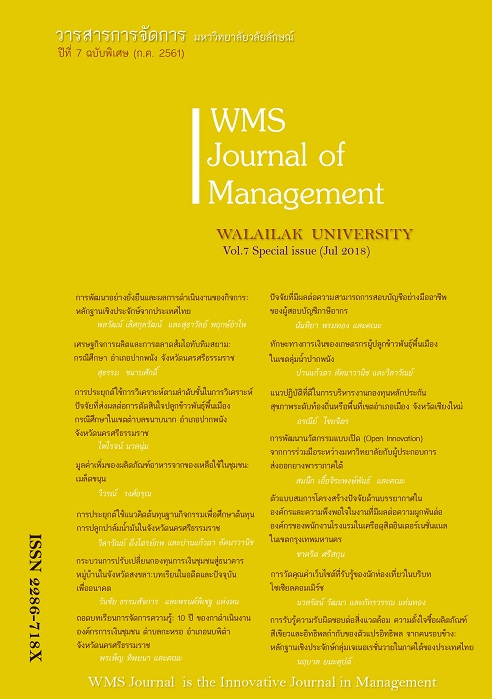An Application of the Analytical Hierarchy Process (AHP) in Analyzing Factors Influencing Decision-making on Local Paddy Rice Cultivation: Case Study of Khanabnak sub district, Pak Phanang district, Nakhon Si Thammarat province
Main Article Content
Abstract
In order to succeed in promoting the cultivation of quality local paddy rice to raise the income and quality of life of farmers, it is necessary for policy makers to understand the farmers’ views and attitudes to local paddy rice cultivation. This paper applies Analytical Hierarchy Process (AHP) in order to explore factors influencing decision-making on local paddy rice cultivation. Based on Ternary Analytical Hierarchy Process (T-AHP), the priority weights of the factors were calculated and Wilcoxon signed-ranks test was applied for comparing the priority weight. Data for analysis were derived from questionnaire survey of 40 farmers in Khanabnak sub district, Pak Phanang district, Nakhon Si Thammarat province. The results indicate that
the dominant-influence factors influencing decision-making are outcome expectation to obtain paddy rice for household consumption and productivity factors (land topography and water supply). In addition, the normal-influence factors influencing decision-making are the resistance of local paddy rice to diseases or pests, and capacity-related labor factors (capacity of household labors, and their knowledge and skill)
Article Details
References
Bosselmann, A. S. (2012). Mediating factors of land use change among coffee farmers in a biological corridor. Ecological Economics, 80(0), pp. 79-88.
Dewees, P. A. (1993). Trees, land, and labor, World Bank environment paper ; no. 4., World Bank environment paper; no. 4. Washington, DC: World Bank. Available at: http://documents.worldbank.org/curated/en/1993/12/5044256/trees-land-labor (Accessed: 27 December 2013).
DFID. (1999). Sustainable livelihoods guidance sheets, London: Department for International Development. Available at: http://www.ennonline.net/resources/667 (Accessed: 30 January 2014).
Encheva, S. (2010a). On Reducing the Number of Existing Cycles in Connected Graphs Obtained from Comparison Matrices. WSEAS Transactions on Business and Economics, 7(2), pp. 126-135.
Encheva, S. (2010b). Ordinal representation of ranking. In Paper Presented to the Proceedings of the 12th WSEAS international conference on Mathematical methods, computational techniques and intelligent systems, Sousse, Tunisia.
Feinstein, A. R. (1996). Multivariable Analysis: An Introduction, New Haven, CT: Yale University Press.
Geist, H. J. and Lambin, E. F. (2002). Proximate Causes and Underlying Driving Forces of Tropical Deforestation: Tropical forests are disappearing as the result of many pressures, both local and regional, acting in various combinations in different geographical locations. BioScience, 52(2), pp. 143-150.
Heery, E. and Noon, M. (2008). A Dictionary of Human Resource Management, Oxford: Oxford University Press.
Hersperger, A. M. and Bürgi, M. (2009). Going beyond landscape change description: Quantifying the importance of driving forces of landscape change in a Central Europe case study. Land Use Policy, 26(3), pp. 640-648.
Jansen, H. G. P., Damon, A., Rodríguez, A., Pender, J. and Schipper, R. (2006). Determinants of income earning strategies and sustainable land use practices in hillside communities in Honduras. Agricultural Systems, 88, pp. 92–110.
Jensen, R. E. (1986). Comparison of consensus methods for priority ranking problems. Decision Sciences, 17(2), pp. 195-211.
Jitpakdee, R. and Wongsawat, S. (2016). The Participation of rice farmer at Pakpanang Basin in maintaining identity of native rice. Area Based Development Research, 8(2), pp.
Lambin, E. F., Geist, H. J. and Lepers, E. (2003). Dynamics of land-use and land-cover change in tropical regions. Annual Review of Environment and Resources, 28, pp. 205-241.
Likert, R. (1932). A technique for the measurement of attitudes. Archives of Psychology, 22, pp. 5-55.
Mekonnen, A. (1998) Rural energy and afforestation: case studies from Ethiopia. Unpublished PhD Thesis, Department of Economics, University of Gothenburg.
Nualnoom, P. (2014). Sustainability of Alternative Land Uses – Comparing Biofuels and Food Crops in Thailand. Unpublished Doctor of Philosophy, University of Surrey, Surrey.
Nualnoom, P., Wehrmeyer, W. and Morse, S. (2016). Analysing household decision-making on oil palm cultivation in Thailand. Journal of Land Use Science, 11(5), pp. 560-578.
Patel, S. H., Pinckney, T. C. and Jaeger, W. K. (1995). Smallholder wood production and population pressure in East Africa: evidence of an environmental Kuznets curve? Land Economics, 71(4), pp. 516-530.
Peduzzi, P., Concato, J., Kemper, E., Holford, T. R. and Feinstein, A. R. (1996). A simulation study of the number of events per variable in logistic regression analysis. Journal of Clinical Epidemiology, 49(12), pp. 1373-1379.
Saaty, T. L. (1980). The Analytic Hierarchy Process: Planning, Priority Setting, Resource Allocation, New York: McGraw-Hill.
Saaty, T. L. (1994). Fundamentals of Decision Making and Priority Theory with the Analytic Hierarchy Process, Pittsburgh, PA, USA.: RWS Publications.
Schneeberger, N., Bürgi, M., Hersperger, A. M. and Ewald, K. C. (2007). Driving forces and rates of landscape change as a promising combination for landscape change research-An application on the northern fringe of the Swiss Alps. Land Use Policy, 24(2), pp. 349-361.
Spector, P. E. (2004). Social Desirability Bias. in Lewis-Beck, M. S., Bryman, A. and Liao, T. F., (eds.) The SAGE Encyclopedia of Social Science Research Methods,Thousand Oaks, CA: Sage Publications, Inc. pp. 1045-1046.
Takahashi, I. (1990). AHP Applied to Binary and Ternary Comparisons. Journal of Operations Research Society of Japan, 33(3), pp. 199-206.
Takeda, E. (2001). A method for multiple pseudo-criteria decision problems. Computers & Operations Research, 28(14), pp. 1427-1439.
Watson, D. (1992). Correcting for Acquiescent Response Bias in the Absence of a Balanced Scale: An Application to Class Consciousness. Sociological Methods & Research, 21(1), pp. 52-88.


